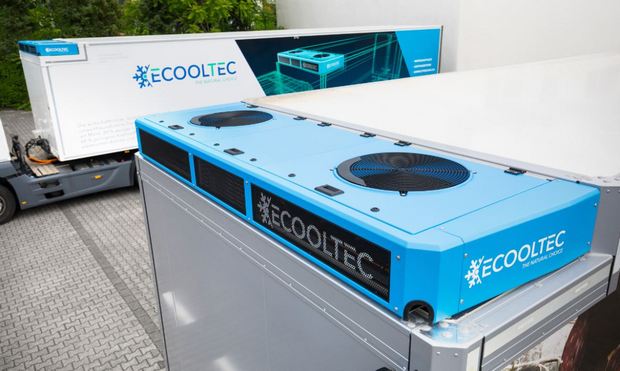ECOOLTEC develops hydrocarbon-based electric refrigeration unit for trucks

The newly founded German transport refrigeration specialist ECOOLTEC Grosskopf has released an electrically driven transport refrigeration unit for trucks, including semi-trailers and rigid vehicle bodies, that uses a small charge of hydrocarbon propene (R1270) as the primary refrigerant, together with CO2 (R744) in the secondary circuit.
The TM182 refrigeration unit can be operated electrically from the truck engine via an in-house high-performance alternator, a battery, or a separate power generator, negating the need for an integrated diesel engine. “Unlike widely used diesel refrigeration machines, the ECOOLTEC unit produces neither local pollutant nor CO2 emissions when in battery operation, and up to 98% fewer emissions via the alternator drive,” according ECOOLTEC.
HFCs such as R452A and R410A are predominantly used in transport refrigeration; however these are subject to ongoing refrigerant phase downs. This will restrict the operational life of refrigeration systems, especially if refrigerants are no longer available for servicing. Rising prices for F-gases are already causing operating costs to rise considerably. By contrast, “hydrocarbons are characterised by a high energy efficiency of the refrigeration process and offer good availability at a competitive price,” said ECOOLTEC.
Limiting leaks and flammability risk
Since R1270 is flammable, ECOOLTEC has secured the system against leakage through a patent-pending, fully hermetic refrigeration circuit that uses a reduced refrigerant charge 90% smaller than that of conventional transport refrigeration systems.
The refrigeration process takes place completely outside the cargo hold. In the unlikely event of a leak, the R1270 immediately mixes with the ambient air and evaporates, said ECOOLTEC. This prevents the formation of a flammable mixture. In the box body, CO2 ensures cold distribution. The R1270 and CO2 circuits flow past each other outside the body via a plate heat exchanger and are thus thermally linked.
The refrigeration system has a large refrigerating capacity to meet the temperature safety requirements of food distribution, said ECOOLTEC. The unit uses specially developed scroll compressors in a horizontal design. Thanks to variable speed control, the system offers high energy efficiency with low operational vibrations and extremely low noise emissions, said the company.
Even in high ambient temperatures, the availability and operational reliability of the system is maintained through refrigerant injection, ECOOLTEC noted. System efficiency was increased by engineering larger heat transfer surfaces without the need to increase overall unit dimensions, the company added.
“This makes the unit suitable for even the most demanding applications, particularly those with high load volumes, lowest box room temperatures, and frequent door openings,” said ECOOLTEC. “As a result, the TM182 offers the highest temperature safety and the shortest pull-down times under all conditions.”
When operating at the same cooling capacity, the system uses 60–80% less energy than a conventional diesel-powered system, said ECOOLTEC. “Highly efficient natural refrigerants as well as large heat exchanger surfaces in combination with a high air flow rate ensure unrivalled efficiency.”
The compact unit’s height is 250mm (9.8in), designed for integration into the vehicle roof without significant loss of loading volume. With the quick-change system, the roof refrigeration unit can be removed or replaced in minutes for easy maintenance, said the company.
Thanks to its custom-designed inverter, the unit can be connected to all common types of drives.
